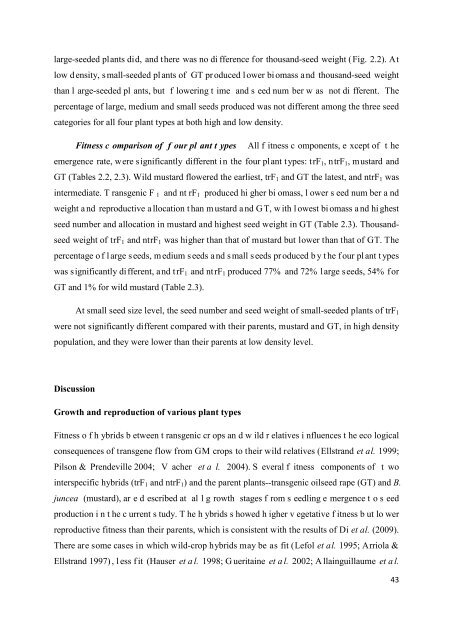UNIVERSITE DE BOURGOGNE THÈSE Yongbo LIU - Université de ...
UNIVERSITE DE BOURGOGNE THÈSE Yongbo LIU - Université de ...
UNIVERSITE DE BOURGOGNE THÈSE Yongbo LIU - Université de ...
You also want an ePaper? Increase the reach of your titles
YUMPU automatically turns print PDFs into web optimized ePapers that Google loves.
large-see<strong>de</strong>d plants did, and there was no di fference for thousand-seed weight (Fig. 2.2). At<br />
low d ensity, s mall-see<strong>de</strong>d pl ants of GT pr oduced l ower bi omass a nd thousand-seed weight<br />
than l arge-see<strong>de</strong>d pl ants, but f lowering t ime and s eed num ber w as not di fferent. The<br />
percentage of large, medium and small seeds produced was not different among the three seed<br />
categories for all four plant types at both high and low <strong>de</strong>nsity.<br />
Fitness c omparison of f our pl ant t ypes All f itness c omponents, e xcept of t he<br />
emergence rate, were significantly different in the four plant types: trF1, ntrF1, mustard and<br />
GT (Tables 2.2, 2.3). Wild mustard flowered the earliest, trF1 and GT the latest, and ntrF1 was<br />
intermediate. T ransgenic F 1 and nt rF1 produced hi gher bi omass, l ower s eed num ber a nd<br />
weight a nd reproductive a llocation t han m ustard a nd G T, w ith l owest bi omass a nd hi ghest<br />
seed number and allocation in mustard and highest seed weight in GT (Table 2.3). Thousandseed<br />
weight of trF1 and ntrF1 was higher than that of mustard but lower than that of GT. The<br />
percentage o f l arge s eeds, m edium s eeds a nd s mall s eeds pr oduced b y t he f our pl ant t ypes<br />
was significantly different, and trF1 and ntrF1 produced 77% and 72% large seeds, 54% for<br />
GT and 1% for wild mustard (Table 2.3).<br />
At small seed size level, the seed number and seed weight of small-see<strong>de</strong>d plants of trF1<br />
were not significantly different compared with their parents, mustard and GT, in high <strong>de</strong>nsity<br />
population, and they were lower than their parents at low <strong>de</strong>nsity level.<br />
Discussion<br />
Growth and reproduction of various plant types<br />
Fitness o f h ybrids b etween t ransgenic cr ops an d w ild r elatives i nfluences t he eco logical<br />
consequences of transgene flow from GM crops to their wild relatives (Ellstrand et al. 1999;<br />
Pilson & Pren<strong>de</strong>ville 2004; V acher et a l. 2004). S everal f itness components of t wo<br />
interspecific hybrids (trF1 and ntrF1) and the parent plants--transgenic oilseed rape (GT) and B.<br />
juncea (mustard), ar e d escribed at al l g rowth stages f rom s eedling e mergence t o s eed<br />
production i n t he c urrent s tudy. T he h ybrids s howed h igher v egetative f itness b ut lo wer<br />
reproductive fitness than their parents, which is consistent with the results of Di et al. (2009).<br />
There are some cases in which wild-crop hybrids may be as fit (Lefol et al. 1995; Arriola &<br />
Ellstrand 1997) , l ess f it (Hauser et a l. 1998; G ueritaine et a l. 2002; A llainguillaume et a l.<br />
43
















